Author: Brian Hall
A stuck fermentation has got to be one of the more frustrating things a brewer can experience. Whereas the typical mash process produces wort with a blend of both simple and complex sugars, a common culprit for fermentation stopping too soon is an overabundance of the latter, which brewers yeast is unable to metabolize. This results in an underattenuated beer that can be sweeter and lower in alcohol than intended, and the solutions of which are very limited. A rather curious option for brewers looking to fix such a problem involves dosing the beer with an enzyme known to break down complex sugars so that they are made more easily digestible, not just by brewers yeast, by humans as well.
Beano is a widely available supplement taken by people to help control digestive discomfort and flatulence. It does this via the enzymes alpha-galactosidase (α-GAL) and invertase that break down the complex carbohydrates of gas-producing foods, ultimately aiding in more comfortable digestion. If it works for guts, why not beer?
Using Beano as a fix for unexpectedly high FGs isn’t that new, clever brewers have been recommending it for decades, often accompanied by cautionary tales of beers that dropped to 1.000 SG or lower. More recently, unarguably inspired by the advent of the super dry Brut IPA style, interest in the use of enzymes for the purpose of driving fairly extreme degrees of attenuation has spiked. And while various products exist that purportedly accomplish this task, none are as readily available as Beano, which can be found in most corner stores.
I’ve made a few beers in my day and have never ended up with a stuck fermentation, so using enzymes is something I hadn’t really considered. Given the growing use of enzymes as a way to facilitate dryness, I decided to test it out for myself!
| PURPOSE |
To evaluate the differences between two beers where one was dosed with Beano and the other is left alone.
| METHODS |
Concerned the hop character of a Brut IPA might overshadow any potential flavor and aroma impact of Beano, I went with a much lighter and less hoppy style for this xBmt.
Cuisino
Recipe Details
| Batch Size | Boil Time | IBU | SRM | Est. OG | Est. FG | ABV |
|---|---|---|---|---|---|---|
| 5.5 gal | 60 min | 28.5 IBUs | 4.0 SRM | 1.037 | 1.012 | 3.3 % |
| Actuals | 1.037 | 1.007 | 3.9 % | |||
Fermentables
| Name | Amount | % |
|---|---|---|
| Pelton Pilsner Style Malt (Mecca Grade) | 4.5 lbs | 58.54 |
| Lamonta American Style Pale Malt (Mecca Grade) | 1.75 lbs | 22.76 |
| Vanora Vienna-style Malt (Mecca Grade) | 1.125 lbs | 14.63 |
| Wickiup Wheat Malt (Mecca Grade) | 3 oz | 2.44 |
| Victory Malt | 2 oz | 1.63 |
Hops
| Name | Amount | Time | Use | Form | Alpha % |
|---|---|---|---|---|---|
| Perle | 10 g | 60 min | Boil | Pellet | 8 |
| Saphir | 21 g | 30 min | Boil | Pellet | 3.7 |
| Tettnang | 21 g | 15 min | Boil | Pellet | 3.5 |
| Tettnang | 30 g | 10 min | Boil | Pellet | 3.5 |
Notes
| Water Profile: Yellow Balanced in Bru’n Water |
Download
| Download this recipe's BeerXML file |
My first order of business on brew day was collecting the water for each batch, adjusting it to my desired profile, then using my heat stick to warm it up.

While the water was heating, I weighed out and the milled two identical sets of grain.
It took about an hour for the water to reach strike temperature, at which point I split it evenly between identical kettles. I then incorporated the grains into the water before checking to ensure both reached the same 157°F/69°C mash temperature, which I targeted in hopes of producing wort with more complex sugars.
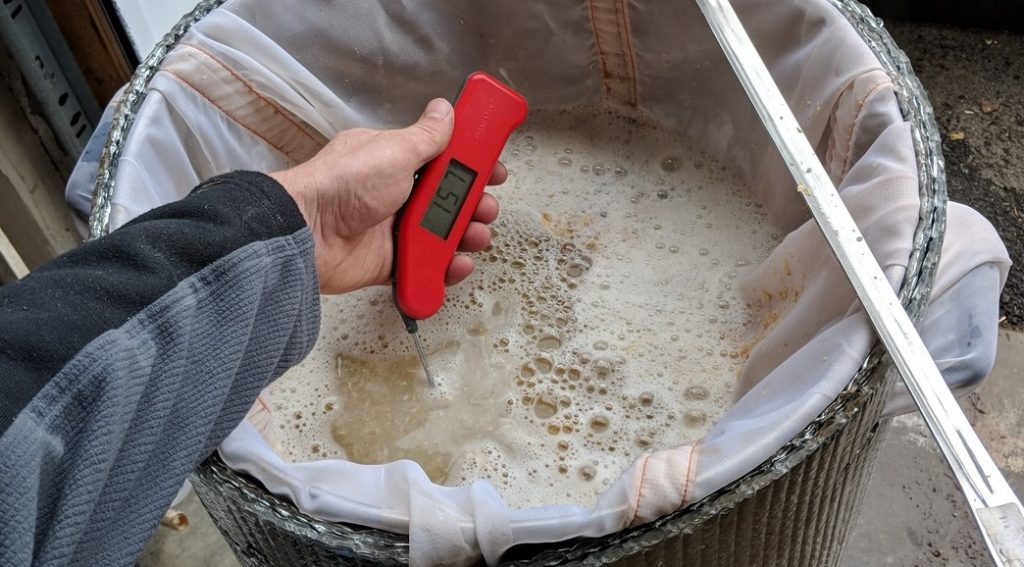
Following a 60 minute mash rest, I removed the grains and let them drip until pre-boil volume was reached.
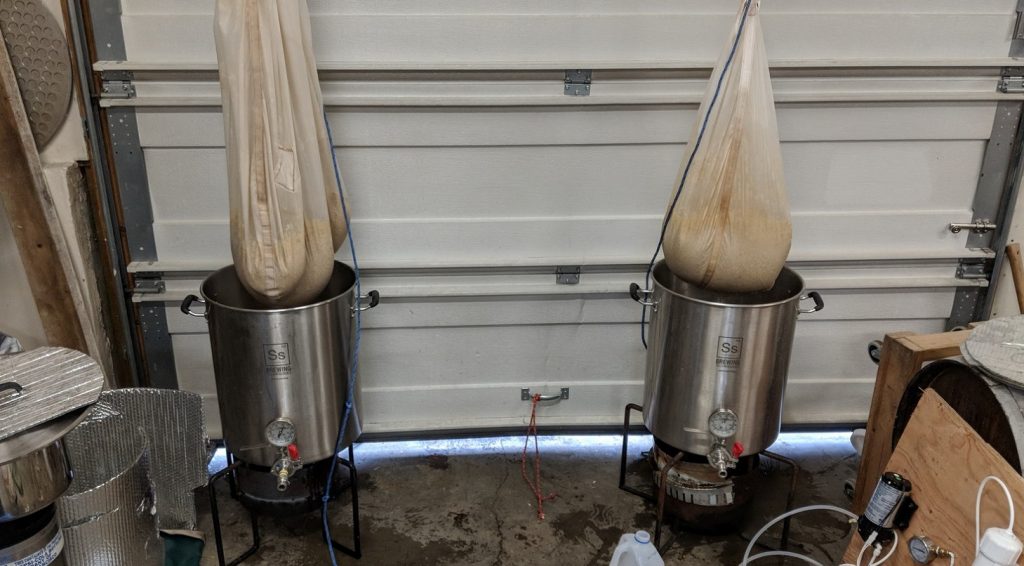
While the worts were heating up, I measured out the kettle hop additions.
Both batches of wort were boiled for 60 minutes with hops added per the recipe.
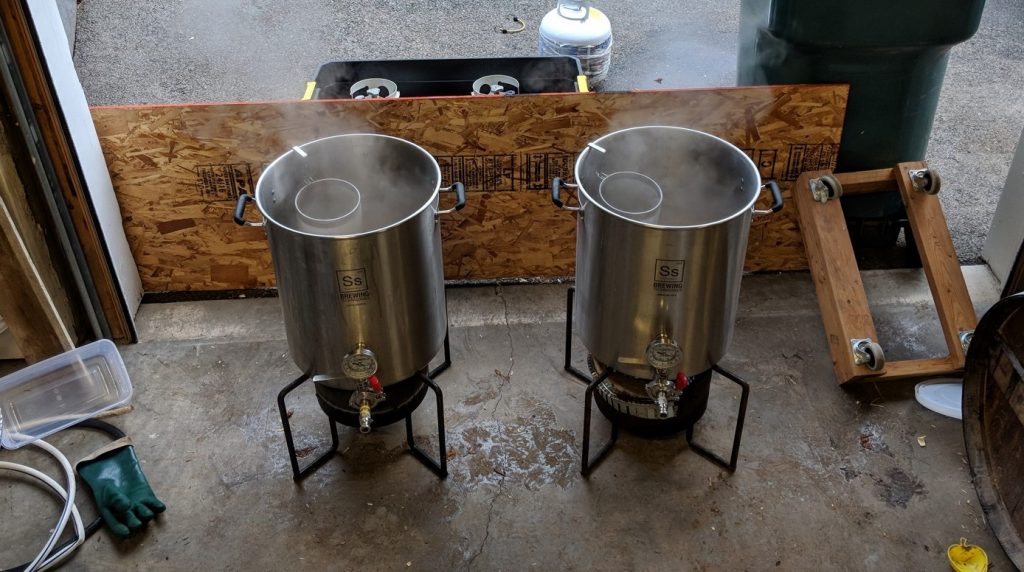
At the end of each boil, I quickly chilled the worts.
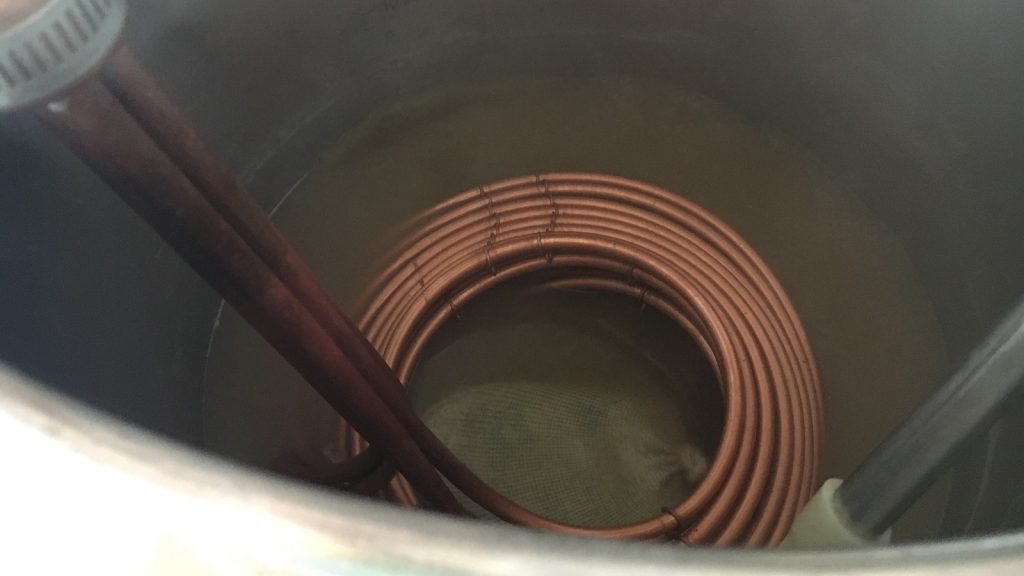
I then combined both worts in a single kettle and stirred to homogenize before taking a hydrometer measurement showing I hit my intended OG.
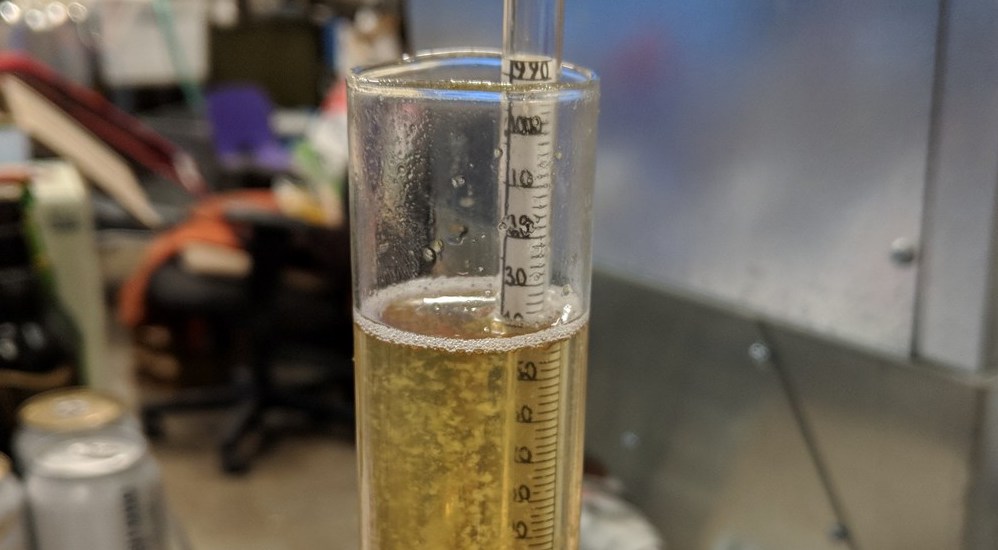
Two identical glass carboys were filled with equal volumes of wort.
At this point, I crushed 10 capsules of Beano and added it to one of the batches of wort.
Each batch of wort with pitched with a pouch of Imperial Yeast L13 Global before I put the beers away to ferment at 57°F/14°C.
After 8 days, I raised the temperature to 68°F/20°C and left it alone for another 5 days before noticing fermentation activity was absent. Hydrometer measurements at this time revealed the Beano beer had attenuated more than the batch without the Beano.
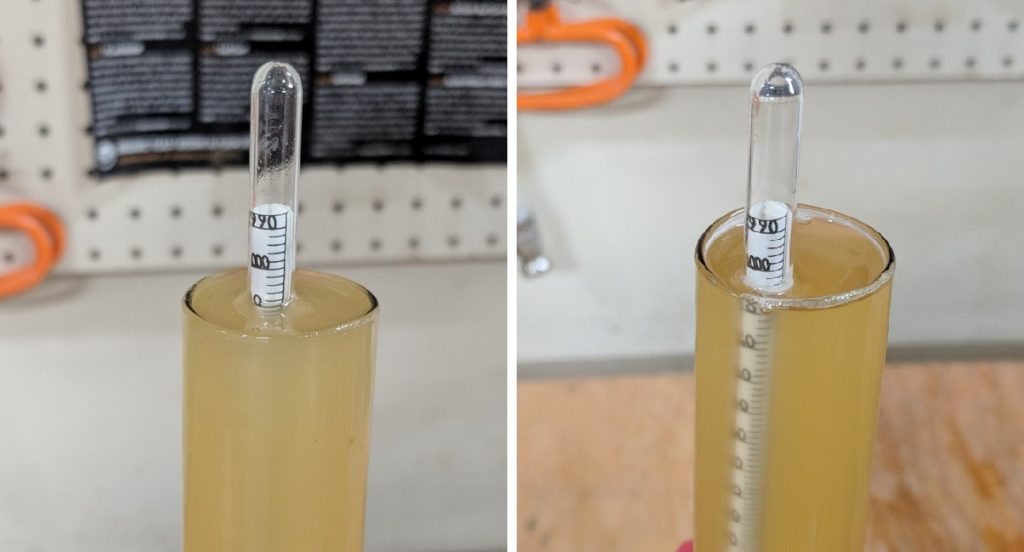
I proceeded with kegging the beers.
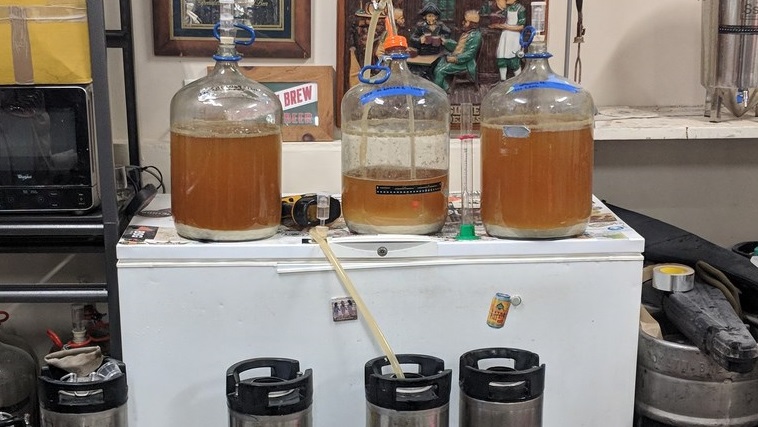
The filled kegs were placed in my keezer where they were carbonated. After a 5 week lager period, the beers were ready to serve.
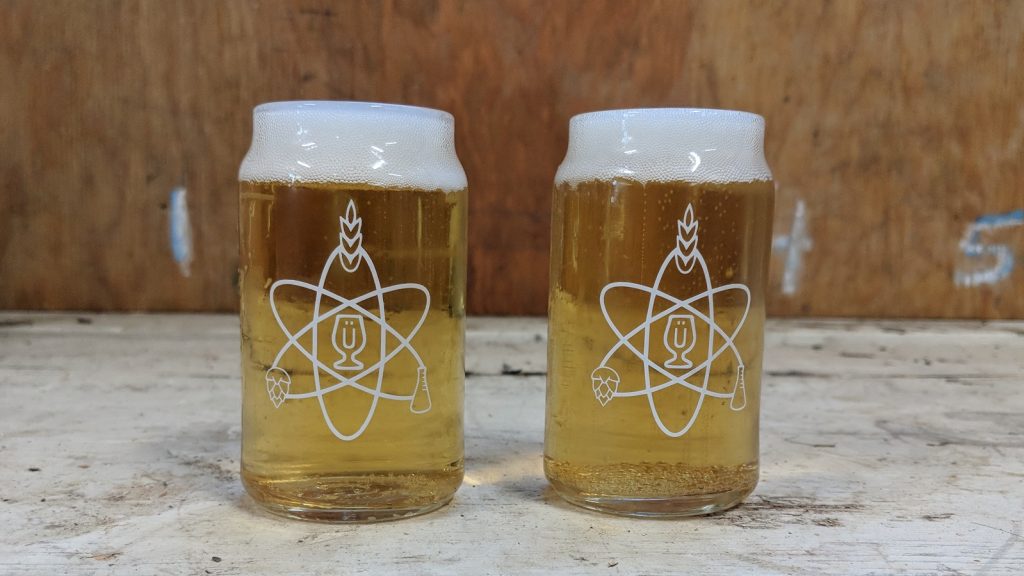
| RESULTS |
A total of 21 people of varying levels of experience participated in this xBmt. Each participant was served 2 samples of the beer made without Beano and 1 sample of the Beano dosed beer in different colored opaque cups then asked to identify the unique sample. At this sample size, 12 tasters (p<0.05) would have had to identify the unique sample in order to reach statistical significance, though only 7 (p=0.58) made the accurate selection, indicating participants in this xBmt were unable to reliably distinguish a pale lager beer dosed with Beano from one that was made without the enzyme.
My Impressions: Even in initial side-by-side samplings, I couldn’t tell a difference between these beers, everything about them seemed identical. Needless to say, I was unable to identify the odd-beer-out in a series of semi-blind triangle tests, despite my inherent bias due to knowing what the variable was. This was easily the lightest beer I’ve brewed, and it was very crushable, I definitely went through more than I intended during my self-assessment!
| DISCUSSION |
There are a variety products currently available that are marketed to brewers as a means to drive attenuation, all of which contain enzymes that breakdown complex sugars such that they’re more easily metabolized by brewers yeast. One such product that’s typically used after beer consumption, is the over-the-counter flatulence reducer, Beano, which has been used for years to combat stuck fermentations and reduce FG in beer. And with the growing popularity of super dry Brut IPA, Beano has experienced a bit of a resurgence in the brewing world.
Indeed, this supported the claim that Beano is able to assist in increasing attenuation, as the beer dosed with Beano finished 0.004 SG points lower than the non-dosed beer. However, as we’ve seen in previous xBmts involving differences in FG, even this difference didn’t appear to have a perceptible impact, as blind tasters were unable to reliably tell the beers apart. And even my biased palate thought they were identical in aroma, flavor, and mouthfeel, as well as appearance.
A very common and completely understandable belief among brewers is that beers with a lower FG will be perceptibly less sweet and have a thinner body than beers with a higher FG. As counterintuitive as it may be, these xBmt results provide further evidence that the complex sugars broken down by the enzymes present in Beano aren’t characterized by the sweetness of more common sugars, and their absence appears to have little if any effect on mouthfeel. The one thing we can say categorically is that the beer dosed with Beano ultimately had fewer remaining carbohydrates than its non-dosed counterpart, which may appeal to those looking to shave a few calories out of their diet.
We certainly plan to continue exploring the use of different enzymes in brewing, particularly as it applies to Brut IPA, though I’m also interested in the impact it has on beers with a very high OG. And just a quick word of caution—there’s little that can be done to counteract Beano’s effect, so make sure you’re okay with a lower FG and higher ABV before adding it to your beer.
If you have any thoughts about this xBmt, please do not hesitate to share in the comments section below!
Support Brülosophy In Style!
All designs are available in various colors and sizes on Amazon!
Follow Brülosophy on:
FACEBOOK | TWITTER | INSTAGRAM
If you enjoy this stuff and feel compelled to support Brulosophy.com, please check out the Support page for details on how you can very easily do so. Thanks!


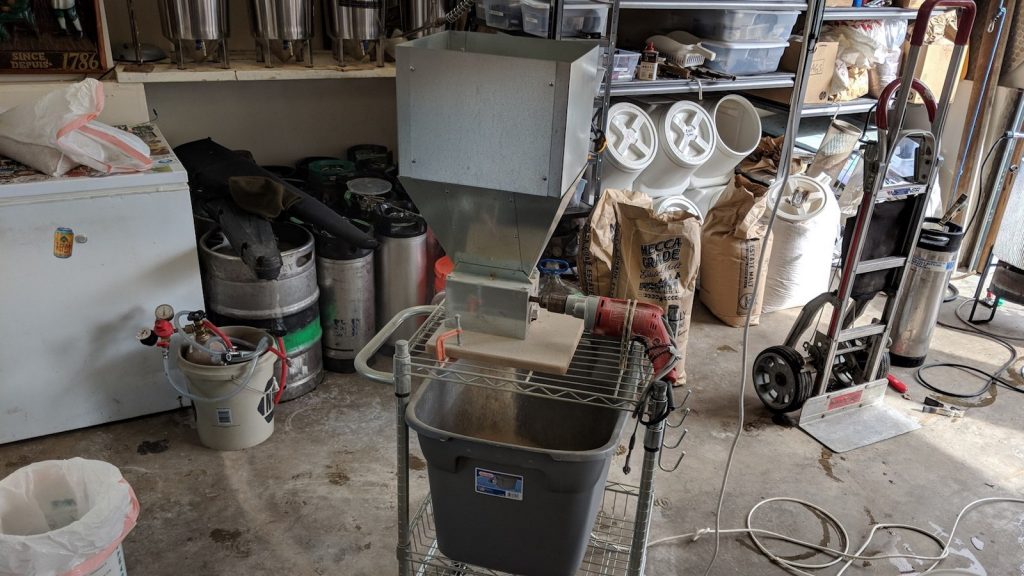
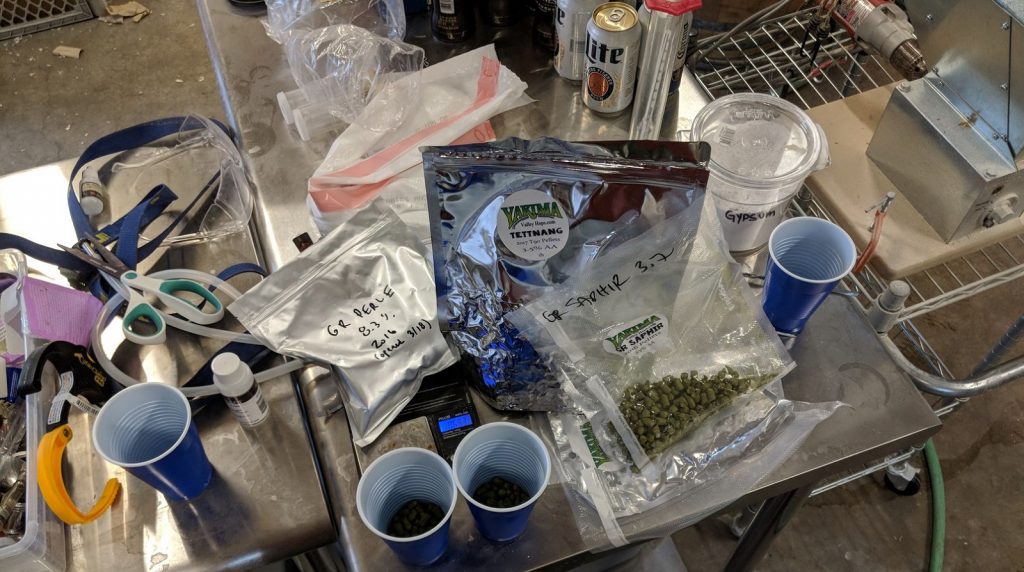
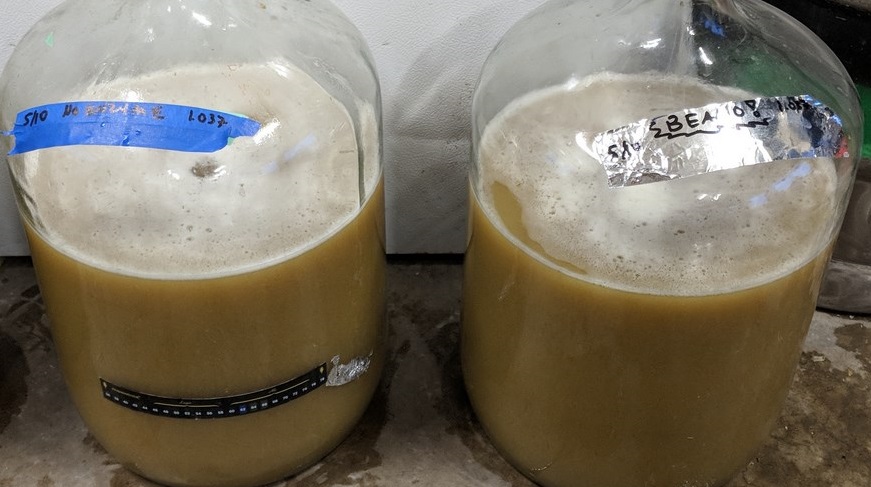
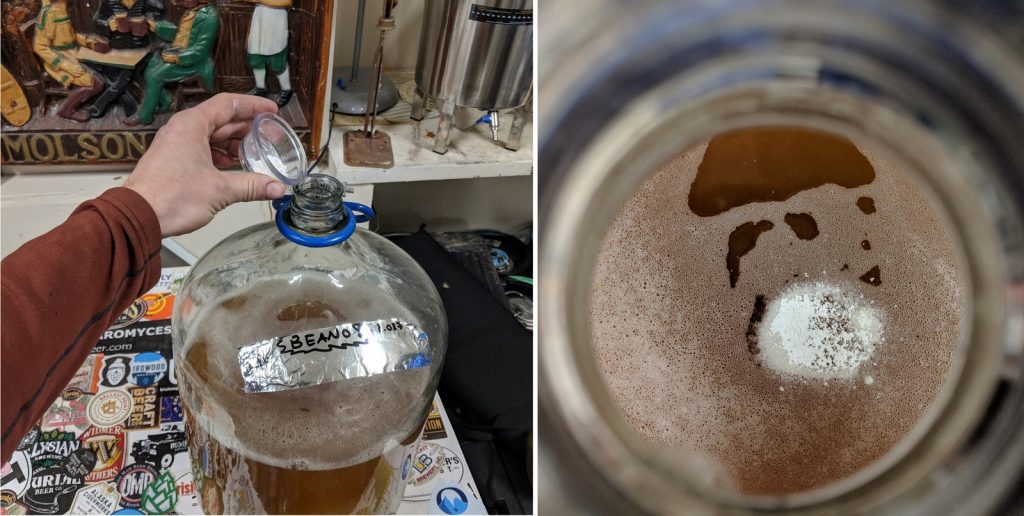
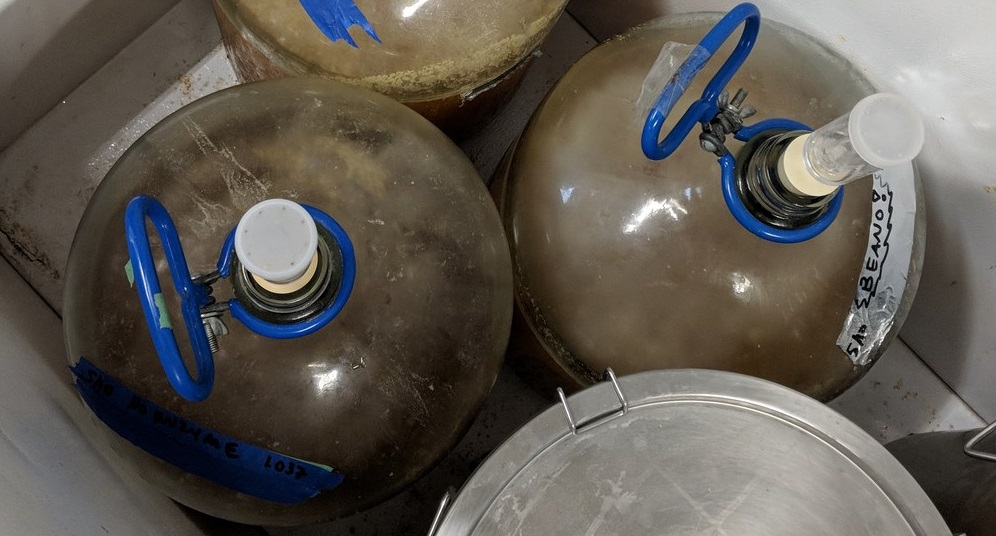










39 thoughts on “exBEERiment | Impact Adding Beano At Yeast Pitch Has On German Leichtbier”
Hey, thanks for doing this. Just a minor note :
amount of carbs will be less, but calories will be about the same, one having more alcohol calories, and the other having more carbohydrate calories.
Not entirely true, CO2 and metabolic losses result in less than 100% fermentables to alcohol conversion.
Not exactly, you are proposing an impossible chemical reaction. The enzyme doesn’t convert one gram of complex carbohydrate (4 calories) to 1 gram of alcohol (7 calories), as that would violate the laws of thermodynamics (less energy cannot become more energy).
The enzyme simply splits the complex carbohydrates into simpler carbohydrates that are then fermented to CO2 plus alcohol by yeast. Some carbohydrate mass (energy) is lost to the inefficiency of yeast metabolism (~30%) and some energy is lost as CO2, therefore the yield of alcohol contains less energy (calories) than the original complex carbohydrates.
This is also evident from using calorie calculators for beers; the lower the finishing gravity, the lower the number of calories.
How many carbs does it knock off a 5 gal batch? approx?
What was the dosage amount of Beano used?
How much was AMOUNT of Beano?
Ha ha, I was wondering this too…
10 capsules.
Way cool.
I’ve successfully rescued two beers using amylase enzyme. It works similar to Beano but “knows” when to stop. The amount added evidently determines how much it will drop gravity. I think I added 0.3 tablespoons for a 5 gallon batch.
I rescued a milk stout that stopped at 1.033. (mashed too high on my new-at-the-time induction unit). Warming it, stirring it, adding more yeast–nothing worked. I found an obscure reference of using amylase, ordered some, tried it, and my milk stout dropped from 1.033 to my expected 1.021 and stopped.
I still have one or two left from that 2-year old batch and it’s one of the better milk stouts I’ve made.
So, curious about your statement – would that not be a reflection of poor conversion (mash) on your part if adding Alpha-A to the stuck fermentation helped? I assume Alpha-Gal and Alpha-A are completely different entities.
Thanks for another great exBEERiment! I find it interesting that while this factor did affect FG, it didn’t affect perception, especially mouthfeel. Considering that, with the exception of Brut styles, most people who are considering Beano are probably dealing with much higher OG/FG, are you all considering another exBEERiment with an imperial, or something else with a full bodied beer?
I just finished an imperial stout that I intentionally mashed high for a full bodied mouthfeel, since I was going to add a half bottle of oaked bourbon, which should dry it out. Well, it worked too well! Mashed @ 155, OG 1.084, FG was… 1.036. Gah!
I wonder if Beano could be added after primary, to any effect? And, if FG hasn’t affected mouthfeel in your tests, would it even be worth it?
See my earlier reply. Amylase enzyme will bring it down to more sane levels and stop at “normal” gravity whereas Beano will keep chomping until it can’t chome no mo’.
Potentially someday!
I recently had a beer finish at 1.013, with a target of 1.008 (had to scramble and find a replacement online beer calculator as the one I had been using was discontinued – it’s time to invest in a good one).
Could I have added the Beano at that point to drop the FG?
I would personally call it a win. Not enough of a difference to matter.
It could lower the FG, but some people have observed beano can ferment down to 1.000 or less. By adding you may dry it out, but lose control of the FG.
Interesting that you chose such a light beer… generally I’ve found the enzyme recommendation to accompany high OG beer recipes and kits. I’d do a vienna/pils Helles/Maibock and bump the gravity up or some other basic/non-complex high gravity beer and do this again.
I’m also interested in the effect on a very high OG beer.
Let me know how it works out!
I’d be interested if you tried this again in a higher OG beer with a similar mash temp. Maybe something like 1.050-1.060. More sugars overall might lead to a more conclusive result. Maybe…. haha
Well, I will continue to put crushed beano into my single malt mash 🙂 Whisky rock!
Like some others here I’m wondering about ability to add later in fermenter for stuck fermentations.
I’ve never had a problem with low OG beers getting good fermentation. Twice I’ve had problems with bigger lagers (Dunkles German Bock). First time with problem it stopped at 1.022. Second time had problem it seemed to stall slightly lower than that and I believe I added fresh yeast and shook the fermenter and gave it another week, and it dropped to 1.015 or so.
Just (yesterday) brewed my first ever Imperial IPA. And after buying the malt read Jamil’s notes along with some online recommending adding 10% sugar to get full fermentation, and finish lower FG. Crud! Ended up adding just over 7% table sugar. Pitched yeast last night.
So two questions…
1) Is it effective to add to a stick fermentation. If so add at what amount per volume?
2) Could I have added Beano to IIPA high OG mash instead of sugar to ensure complete fermentation. And if so at what level / amount per volume.
Until the Bruboys do some xbmt on high gravity beers, I’d recommend you check out amylase enzyme instead for stuck fermentation. It will not ferment all the way like Beano.
1. It could help a stuck fermentation in theory, but it may dry out more than you want. I’m not sure what appropriate amounts would be.
2. It depends what you are after. Adding sugar doesn’t complete fermentation, but it can lower the FG due to the alcohol increase.
Interesting experiment. Results makes sense and it’s good to see that the Beano didn’t produce any off flavors. Makes sense why you’d choose a light beer for this.
Previous experiments about taste perceptions on under attenuated beers aside, I think there’s a LOT to be said for attenuating a beer a fully as possible. Namely: stability. Excess starch/dextrin is an invitation for (at best) on going, low level fermentation and (at worst) infection.
Gogin to start keeping some Beano on hand I think.
The beer with Beano dropped 1% more in gravity. I’m not entirely sure what was expected when formulating this experiment
Sorry, fudged the calculation. It’s about 8% gain in apparent attenuation (81 to 89%). Still not entirely noticeable however
My calculations (1.037-> 1.003) vs (1.037->1.007) say 92% vs 81%. I definitely thought that would have been noticeable.
I agree with above – that is a noticeable drop in FG. I am really surprised that drop could not be detected (only 7 people). Sounds like a club Experiment I have to do now.
For such a dry beer to begin with? Nah. The average human palate is pretty limited. I believe one experiment compared 1.023 to 1.008, and less than half of the participants could tell the difference.
If I add Beano to “unstick” a fermentation and bring down the FG, will it continue to do its thing after bottling, breaking down normally unfermentable sugars, feeding the live yeast and cause a gusher or worse, a bottle bomb? Not all of us keg.
There is the potential for bottle bombs. One way to get around this is to pasteurize.
It’s not that big a deal, just give the yeast sufficient time to complete fermenting. This is akin to using a diastatic yeast strain; there is no reason that the beer cannot be bottled if all the fermentable carbohydrates have been fermented. Ramping up temperature is a wise idea with diastatic yeast or enzyme use to ensure complete fermentation. Then bottle away…
Yes!–see my post below.
Boy this experiment really stinks!
Great XBeeriment. I used alpha-amylase in a beer that “stopped short”, and it worked too well. It was a Dubbel–Westvleteren 8 clone attempt–and I probably should have just heated it up somehow to get it to finish. If memory serves, I think it quit in the high 20’s, and was quite sweet. After bottling, it kept going and fermented down to about 1.009. (1.081 OG). Gushers. Surprisingly and luckily, I didn’t have any bottles blow up. I think I preferred the taste when it was sweeter. I think the problem is, that at room temp. it works pretty slowly. So if you’re bottling, it can still be chewing up dextrins, and the yeast will keep fermenting the sugars slowly.
Will this Beano treatment help a stuck fermentation caused by a weak or a low yeast count?
Related anecdote from the last week. I just used something other than Beano, (which I wish I’d known about), and got an accidental “brut” for my troubles.
I had an IPA fermentation stall when I dropped dry hops at 1.020. After a week of failing with normal methods (rousing, temp rise, fresh yeast), I pulled the hops out and hit it with 1ml of Amylo 300. I dumped the yeast cake and the lowered the temp to 60 as the beer hit 1.008, but it kept dropping all the way to 1.000, at which point I dropped temp to 33 and used gelatin. I THINK it was done, but just in case… The data sheet for Amylo 300 lists “stuck fermentation,” as a use for the product, but as the “unfermentables” are suddenly fermentable, why would it stop?
During this whole adventure, a Tilt hydrometer provided a regular data stream. I didn’t like what it was saying, but appreciated having the data without having to take samples.
The play at this point is to carbonate the heck out of it and pretend that it was supposed to be a “Brut IPA” from the beginning.